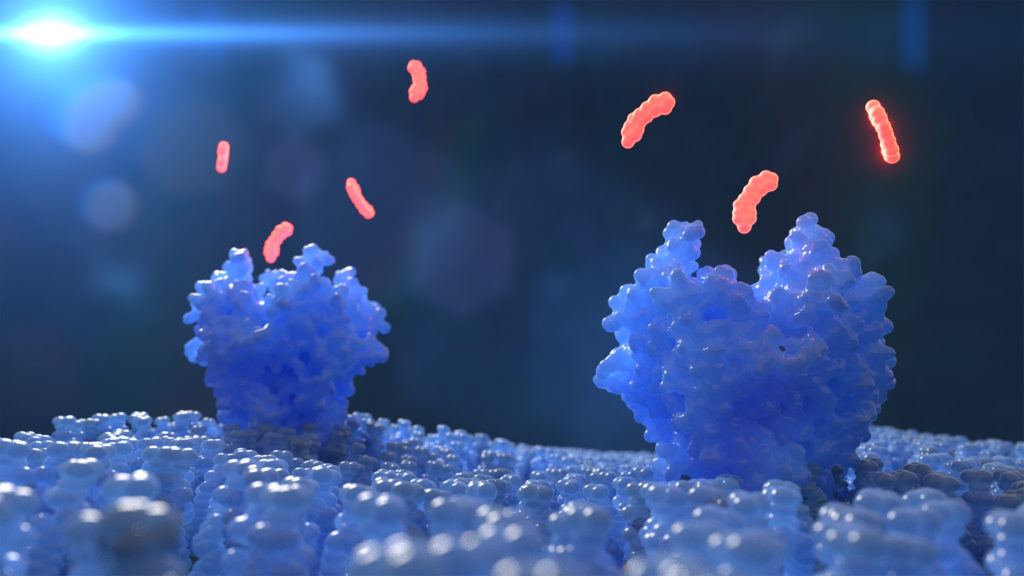
The way that psychoactive drugs work in the brain is through interaction with different receptors, transporters, or enzymes that, in turn, alter regular functioning. Receptors are the main targets for psychedelics, usually G-protein coupled receptors (GPCRs) or sometimes ion channels.1-2 Measuring things like receptor activation and biological responses can give key insights into signaling mechanisms and the effects of psychedelic compounds. But, sometimes these tests can be hard to understand. This article breaks down the basics of two receptor assays.
Radioligand Binding Assays
Common types of binding assays utilize a radioligand that is unique to the receptor class to study the interactions of a drug with a target receptor. Three major types are used:2,3
- Saturation binding: This assay reveals the equilibrium dissociation constant Kd, which is reflective of the affinity a drug has for a receptor. A low Kd value means a high affinity of the drug to activate the receptor.
- Competition binding: This test uses a radiolabeled ligand with a non-labeled competing ligand to determine the binding affinity and selectivity of a drug for its given receptor target. This binding data is sometimes referred to as the inhibition constant, or Ki.
- Kinetic binding assays measure the dissociation and association rates of a drug through specific binding of a radioligand. This information can be used to determine if there are cooperative binding interactions occurring between multiple compounds.
All of these assays can be done using homogenized tissue, cells, or tissue slices, and are typically measured using a scintillation counter.
It is important to note that receptor affinity is not the same thing as potency. The potency of a drug is basically how much is needed to produce a particular effect. Affinity refers to how well a drug binds to a receptor. In order to calculate the potency of a drug (the EC50), the efficacy (Emax), or maximum effect expected from the drug, must also be determined. This can be accomplished through functional assays.
Functional Assays
Functional assays refer to measuring the change in a biological response, and in the context of psychedelics, it is usually an agonist response.4 These assays can be behavioral-based animal studies, cell-based experiments, and enzymatic reactions, and can all reveal potencies of psychedelic compounds. Functional assays should reflect the drug’s mode of action, be reproducible, accurate, robust, stability-indicating, and practical.5
An example of a behavioral functional assay is the head twitch response (HTR) assay, a rodent model for serotonin 5-HT2A receptor activation. Typically, the number of recorded HTRs following drug administration is analyzed as a response vs. time. The potencies of each compound can be calculated by finding the dose required to induce a half-maximal response, the effective dose (ED50). This allows for comparisons between compounds or across different concentrations. A recent study led by Dr. Adam Halberstadt provides a new framework for comparing the potencies of hallucinogenic compounds obtained via HTR testing to subjective and behavioral effects across species.6
An example of a cell-based function assay is the calcium mobilization assay used to evaluate the potency of psychedelics. Most classic hallucinogens activate the 5HT2A receptor, a Gq-coupled receptor that causes downstream calcium influx into cells.7 This assay measures the movement of calcium following the treatment of cells with different concentrations of a psychedelic. This method utilizes a calcium-sensitive fluorescent dye that is taken up by the cell. Fluorescence is measured following an incubation period, or in real-time, and is quantified to reveal the ED50 to compare between compounds or different concentrations.8-9
Conclusion
Drug effects depend on the occupation of receptors, how they modulate that receptor’s activity, and the experimental measure used to quantify the effects. Radioligand binding assays and functional assays are two tests that researchers use to understand how psychedelic compounds work together at the receptor level in the brain. These assays are fundamental tests that are used well before a drug (especially potent ones like psychedelics) heads down the path to clinical trials. Understanding the complex interplay, and perhaps synergy, between psychedelic compounds and receptor proteins is an essential step for advancing psychedelic research.
